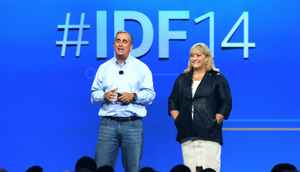
Intel Developer Forum 2014: Intel Corporation CEO Brian Krzanich kicked off Intel's annual technical conference with a clear focus on new markets such as wearable tech, mobile and connected devices. While Intel continues to push the limits in the traditional computing spaces, the focus of this years IDF was clear - Intel is going after the new device categories and is preparing hard to develop the hardware and the software development kits (SDKs) to enable developers and manufacturers to quickly integrate its latest solutions into mass market products for new device categories. Over the next few slides, it will be evident that IDF 2014 was all about Intel's new initiatives and products that are well beyond the traditional PC space.
No, they aren't ignoring the PC space, showcasing new Core M based hybrid PCs with fan-less design and a glimpse of the Skylake platform is an assurance of the fact that they will continue to press for dominance in the microprocessor segment, while targeting to enter several other segments.

Intel Reference Design for Android: At IDF 2014, Intel is sending the strongest signals so far about its seriousness towards Android (Android devices). Intel revealed its new Android Reference Design program for tablets, allowing manufacturers to quickly adopt Intel's x86 based SoCs. Intel seems to be very confident about its reference design program, promising Android updates within two weeks of Google making new releases available. And, they further confirmed that these updates would include both major and minor updates that are officially rolled out by Google
Intel plans to achieve this by providing a single binary image for Android and giving the OEMs and ODMs the choice of selecting a pre-qualified set of components. With rumors about the next Nexus tablet featuring an Intel SoC and the Android reference design program, Intel is working very closely with Google to make a big splash in the Android space.
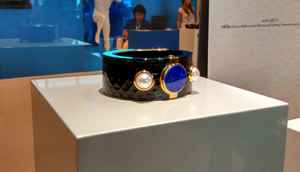
Wearables, but a different approach: One of the new markets that Intel has on its radar - Wearable devices. MICA is Intel's very first wearable market initiative. MICA (My Intelligent Communication Accessory) was unveiled at Fashion Week in New York. MICA is a digitally enhanced fashion accessory, a result of collaboration between Intel and American fashion house - Opening Ceremony. Intel CEO Brian Krzanich defines MICA,"This is something you want to wear independent of the technology inside and when you realize what the technology inside is, you've got to have one". While Intel hasn't revealed much on the core technology aspects of any of its wearable device initiatives, the MICA Smart Bracelet claims that it "allows you to stay connected via SMS messages, meeting alerts, and general notifications delivered directly to the wrist, with additional features and functions to be revealed at a later date." MICA is a platform that Intel is offering for fashion houses and brands to develop smart and connected wearable fashion accessories.
Intel also announced it's partner ship with American watch and fashion accessory brand - Fossil. While there weren't any smart watches announcements or demos at the event, one can expect smart devices and watches from this partnership soon, especially after the announcement of Apple Watch.
Intel does clearly state that the decision to enter the wearable space by partnering with Fashion Brands was a conscious one, wanting to go beyond the usual core tech segment, wanting to cater to the larger fashion conscious mass audience.
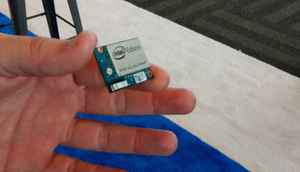
Intel focuses on the 'Makers' with Edison: Apart from developers, Intel is targeting the inventors/builders segment, coined as 'Makers' with Edison. At IDF, Intel announced the availability of Edison, priced at $50 for the core module. Edison uses a 22-nm Intel Atom SoC, with a dual core, dual threaded CPU running at 500 MHz along with a 100 MHz 32-bit Intel Quark processor. Edison houses 1 GB LPDDR3 RAM, 4 GB EMMC storage, and a dual-band WiFi and Bluetooth Low Energy chip. Yes, Edison is a nano computer that is as tiny as a postage stamp (approx 1x1 inch).
Intel sent the first wave of Edison modules to students, asking them to build and invent concepts and products that take advantage of Edison's capabilities.
We spoke to Edward Ross, Senior Director of New Devices Group on Intel's plan on introducing Edison in India and how they plan to encourage young Indian inventors and students to dabble with Edison and create/build unique connected devices. Edward confirmed that Edison will be launched in 65 countries by end of 2014 and India is a part of their November launch schedule. Intel's go to market strategy for India will be about partnering with Incubators and accelerators along with leveraging their relations with partners and distributors
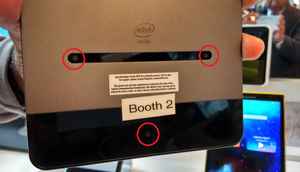
Intel Real Sense Camera: The Dell Venue 8 7000 series is the first commercial product to integrate Intel Real Sense Camera technology. Intel Real Sense Camera utilizes 3 cameras in tandem to capture images, the primary 8MP camera is used to capture the frame while the two 720p cameras are used for depth sensing and measurement. We have covered the Intel Real Sense Camera Technology in-detail along with a quick test, read our Hands-on with Dell Venue 8 with Intel Real Sense to see how it works.
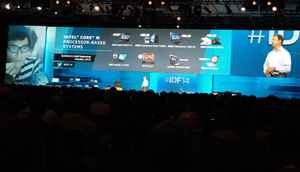
Intel Core M: First taste of 14nm for super-slim fan-less PCs and powerful tablets
Intel Core M is where the major chunk of Intel's revenue will come from. The basics, stuff that Intel has been the leader in, producing smaller, faster and power efficient processors for PCs, Hybrids and Tablets. The Intel Core M series is built on Intel's latest 14nm Broadwell-Y architecture that enables fan-less designs, allowing hybrids PC and tablets to be a lot slimmer, quiter and power efficient. Read our Intel Core M story for more details and specifications on Intel Core M platform.
What Intel Core M means for end-users: In our opinion, the Intel Core M will enable true hybrid PCs and bring high performance to tablets. Intel showcased some of the early hybrid fan-less designs based on the Core M platform and we can safely say that they were far more appealing and usable as compared to the first generation of hybrid PCs which were heavy, clunky and noisy. Just to get things in perspective, Intel Core M will can deliver 12-15 hour battery life and 8-hours of video playback on a single charge. All this on slim and light hybrids/tablets measuring between 8-20mm in thickness!
How fast is the Intel Core M? We will be attending the performance benchmarking sessions today, stay tuned for some numbers and comparisons. Coming soon!

Skylake: New micro-architecture, Wireless charging and 4K WiFi streaming. Skylake will be the follow up to Broadwell, scheduled to make its debut later in second half of 2015. The 14nm Skylake will bring new microprocessor architecture as a follow-up to Broadwell which is a die-shrink.
Skylake will come with embedded wireless charging and wireless streaming support and will combine with all-in-one desktops with built in batteries to offer a truly wire-free experience. That's the plan and while native wireless streaming support is very much on the cards, wireless charging will need a heavy industry push to make wireless charging technology ubiquitous.